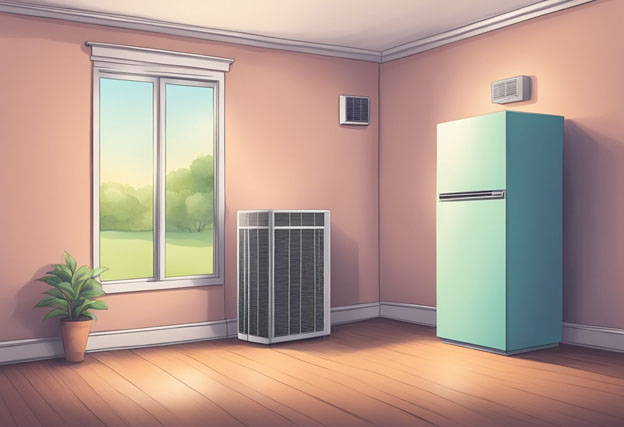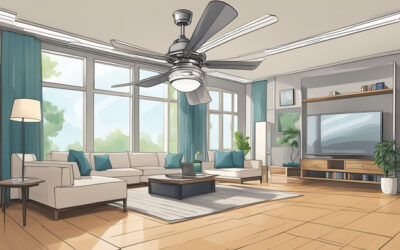Many people believe that turning off the air conditioning (AC) when leaving the house is a good way to save money on their energy bills. However, this common misconception is not entirely accurate. In fact, turning off the AC when leaving the house can actually lead to increased energy usage and higher bills.
The idea behind turning off the AC is that it will prevent the unit from running unnecessarily and wasting energy. While this is true to some extent, it does not take into account the fact that turning the AC off completely can cause the temperature inside the home to rise significantly. When the temperature inside the home rises, the AC unit has to work harder and longer to cool the home back down once it is turned back on. This increased workload can actually lead to higher energy usage and ultimately, higher bills.
Understanding AC Energy Consumption
How AC Systems Work
Air conditioning (AC) systems work by removing heat and moisture from indoor air, making the environment cool and comfortable. AC units have two main components: the evaporator and the condenser. The evaporator is responsible for absorbing heat from inside the house, while the condenser releases the heat outside.
The AC system operates based on the principles of thermodynamics. When a liquid evaporates, it absorbs heat from the surrounding environment, and when it condenses, it releases heat. The refrigerant in the AC system evaporates and condenses repeatedly, transferring heat from inside the house to outside.
Factors Affecting AC Efficiency
Several factors can impact the efficiency of an AC system, including the size of the unit, the age of the system, and the quality of the installation.
The size of the unit should be appropriate for the size of the space it is cooling. An oversized unit can cool a space too quickly, which can lead to wasted energy and increased humidity. On the other hand, an undersized unit may not be able to cool the space effectively, leading to increased energy consumption as it tries to keep up.
The age of the system can also impact its efficiency. Older systems may not be as energy-efficient as newer models, and they may require more frequent maintenance and repairs.
Finally, the quality of the installation can impact the efficiency of the AC system. Poor installation can result in leaks, improper airflow, and other issues that can reduce the effectiveness of the unit and increase energy consumption.
By understanding how AC systems work and the factors that impact their efficiency, homeowners can make informed decisions about how to best manage their AC usage and energy consumption.
Debunking the Turn-Off Myth
Many people believe that turning off their air conditioning (AC) when leaving the house saves them money. However, this is a common misconception that can actually result in higher costs and unnecessary wear and tear on the AC unit.
Cost Implications of Turning Off AC
When the AC is turned off, the temperature inside the house can rise significantly, especially during hot summer months. When the temperature rises, it can take a lot of energy for the AC unit to cool the house back down to the desired temperature once it is turned back on. This can result in higher energy bills and increased wear and tear on the AC unit.
On the other hand, leaving the AC on at a higher temperature when leaving the house can help maintain a more consistent temperature and reduce the amount of energy needed to cool the house back down when returning home. Many modern thermostats even have the option to set a higher temperature when the house is empty and automatically adjust to a cooler temperature when someone is home.
Wear and Tear Concerns
Turning off the AC unit completely can also result in unnecessary wear and tear. When the AC is turned off, the unit must work harder to cool the house back down when it is turned back on. This can put additional strain on the unit and reduce its lifespan.
Leaving the AC on at a higher temperature can help maintain a more consistent temperature and reduce the amount of strain on the unit. Additionally, regular maintenance and cleaning of the AC unit can help ensure it is running efficiently and prolong its lifespan.
In conclusion, turning off the AC when leaving the house is a common misconception that can result in higher costs and unnecessary wear and tear on the unit. It is recommended to leave the AC on at a higher temperature when leaving the house to help maintain a consistent temperature and reduce energy usage.
Optimal AC Practices for Energy Savings
Programmable Thermostats Usage
One of the most effective ways to save energy and reduce your AC bill is by using a programmable thermostat. This type of thermostat allows you to set different temperature settings for different times of the day, which means you can adjust your AC usage based on your daily routine.
For example, if you leave for work at 8:00 AM and come back at 6:00 PM, you can set your thermostat to turn off the AC during the day when no one is home, and turn it back on an hour before you arrive. This way, you won’t waste energy cooling an empty house, and you’ll still come back to a comfortable temperature.
Strategic Temperature Settings
Another way to optimize your AC usage is by setting your thermostat to the most efficient temperature range. The US Department of Energy recommends setting your AC to 78°F (26°C) when you’re at home, and 82°F (28°C) when you’re away.
While this may seem warm, it’s important to remember that every degree you lower your thermostat below 78°F can increase your AC bill by up to 8%. By setting your thermostat to the recommended range, you can save energy and money without sacrificing comfort.
In addition, you can also use fans to circulate air and create a more comfortable environment. Ceiling fans, in particular, can help you feel up to 4°F cooler, which means you can set your thermostat a few degrees higher and still feel comfortable.
Overall, by using a programmable thermostat and setting your AC to the most efficient temperature range, you can save energy and reduce your AC bill without sacrificing comfort.
Alternatives to Turning Off AC
Utilizing Fans for Air Circulation
Instead of turning off the AC completely, homeowners can make use of fans to circulate the cool air throughout the house. This can help to maintain a comfortable temperature while reducing the workload on the AC unit. Ceiling fans, portable fans, and window fans are all effective options for improving air circulation.
It’s important to note that fans do not actually lower the temperature of a room, but rather create a wind chill effect that makes the room feel cooler. Therefore, it’s recommended to turn off fans when leaving the house to conserve energy.
Improving Home Insulation
Another way to reduce the workload on the AC unit is to improve the insulation of the home. Proper insulation can help to keep cool air inside during the summer months and prevent hot air from entering the home. This can be achieved by adding insulation to walls, attics, and crawl spaces, as well as sealing any air leaks around doors and windows.
By improving home insulation, homeowners can reduce their energy bills and make their home more comfortable without relying solely on the AC unit.
Environmental Considerations
Reducing Carbon Footprint with AC Settings
Leaving the AC on while leaving the house is a common misconception that leads to higher energy consumption and a larger carbon footprint. By turning off the AC when leaving the house, one can reduce their energy consumption and save money on their electricity bill. However, it is important to note that simply turning off the AC is not enough to reduce one’s carbon footprint.
One effective way to reduce energy consumption is to set the AC temperature to a higher temperature when leaving the house. For example, setting the temperature to 78°F instead of 72°F can reduce energy consumption by up to 18%. Additionally, using a programmable thermostat can help regulate the temperature and reduce energy consumption when the house is unoccupied.
Impact of Frequent Temperature Changes
Frequent temperature changes can also have an impact on energy consumption and the environment. When the AC is turned off and then turned back on, it has to work harder to cool the house back down to the desired temperature. This can lead to higher energy consumption and a larger carbon footprint.
One way to avoid frequent temperature changes is to set the AC temperature to a constant temperature when leaving the house. This can help maintain a consistent temperature and reduce the need for the AC to work harder to cool the house back down.
Overall, it is important to consider the environmental impact of leaving the AC on when leaving the house. By adjusting the AC settings and avoiding frequent temperature changes, one can reduce their energy consumption and carbon footprint.
Technological Innovations in AC Management
Smart Home Systems
With the advent of smart home systems, homeowners can now remotely control their air conditioning units through their smartphones or tablets. These systems allow users to set the desired temperature and schedule the AC to turn on and off at specific times. Some smart home systems even use sensors to detect when a room is occupied and adjust the temperature accordingly, saving energy and reducing utility bills.
One popular smart home system is Nest, which uses machine learning algorithms to learn the user’s preferences and adjust the temperature accordingly. Another system is ecobee, which allows users to control their AC through voice commands using Amazon Alexa or Google Assistant.
Energy-Efficient AC Models
Energy-efficient AC models are becoming increasingly popular due to their ability to save energy and reduce utility bills. These models use advanced technologies such as variable speed compressors and inverter technology to adjust the cooling output based on the room’s temperature, resulting in significant energy savings.
One popular energy-efficient AC model is the Carrier Infinity 21, which has a SEER rating of up to 21, making it one of the most energy-efficient ACs on the market. Another model is the Lennox XC25, which uses inverter technology to adjust the cooling output and has a SEER rating of up to 26.
Overall, technological innovations in AC management have made it easier for homeowners to control their AC units and save energy. By using smart home systems and energy-efficient AC models, homeowners can reduce their carbon footprint and save money on their utility bills.





0 Comments